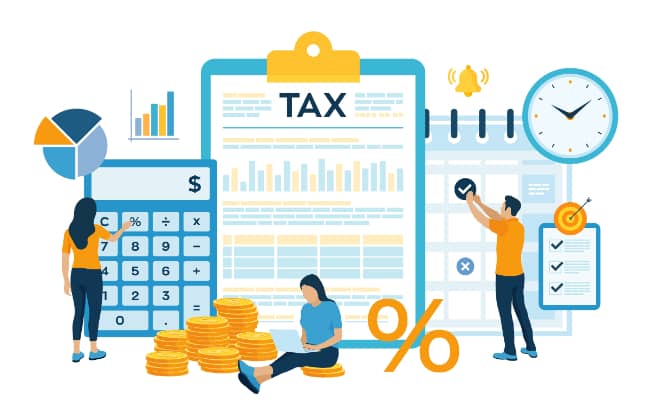How To Find Net Pay: 5 Simple Steps
Taxes may be inevitable, but overpaying isn’t. You just have to understand how taxable income works—and how to make the most of exemptions and deductions.
So, what is taxable income? And how can you avoid paying a penny more than you need to? Here’s a guide to what kinds of income are taxable and how to effectively manage your taxes.
How Does Taxable Income Work?
Taxable income includes most of the money you earn from your job, investments, and other sources. It’s part of your gross income, which the IRS uses to decide how much you owe in taxes each year. Your gross income is the total amount of money you earn before taxes and other deductions.
But not all income is taxable. The IRS calculates taxable income by taking your adjusted gross income (AGI) and subtracting deductions. These include student loan interest and certain retirement account contributions. Deductions lower your taxable income, which means you pay less in taxes.
The IRS uses your taxable income to determine your tax bracket, which decides what percentage of your income goes toward taxes. The higher your taxable income, the more taxes you owe.
FROM ONE OF OUR PARTNERS — Small Business Owner? You Can’t Afford To Ignore These Financial Tips
What Is Considered Taxable Income?

The most common type of taxable income is the income you earn from your job. This includes wages, bonuses, and tips. If you’re self-employed or a freelancer, the money you earn from your business is also taxable.
Investment income is another common type of taxable cash. This includes money earned from selling stocks, bonds, and real estate. It also includes dividends and interest payments you receive.
If you rent out a property, the rent money you collect is taxable. You can deduct certain expenses related to the property, like maintenance and repairs, but you have to pay taxes on the rest of the rental income.
Other types of taxable income include:
- Unemployment benefits
- Pension and annuity payments
- Prizes and awards
- Severance pay
It’s important to keep track of all your sources of income throughout the year. This makes it easier to calculate taxable income when tax season comes around.
RELATED ARTICLE — What Is a Service Business?
What Is Non-Taxable Income?
Most income is taxable, but there are some exceptions. Non-taxable income is money you receive that you don’t have to pay income taxes on. Common examples include:
- Benefits like welfare and disability payments
- Child support payments
- Gifts of money from friends and family
- Life insurance payouts
- Lottery and gambling winnings (in some states)
There are different reasons why these types of income aren’t taxed. For example, gifts and inheritances are classified as transfers of money, not earnings. And public assistance programs help people who are struggling financially, so it wouldn’t make sense to tax them.
Non-taxable income often comes with its own rules and limitations. If you receive child support, you don’t pay taxes on it. But the person paying can’t deduct it from their taxable income. Do your research or consult a tax professional if you’re unsure about the rules for a specific type of income you receive.
How To Calculate Taxable Income in 7 Steps

If you’re feeling a little overwhelmed about calculating your taxable income, don’t worry. It’s a straightforward process when you break it down into steps.
Here’s how to find taxable income:
1. Determine Your Filing Status
Your filing status affects your income tax rate, deductions, and credits. There are five filing statuses:
- Single
- Married filing jointly
- Married filing separately
- Head of household
- Qualifying widow(er) with dependent child
Choose the status that best describes your situation and makes the most financial sense.
2. Gather Your Income Documents
Collect all documents related to your income for the year. These may include:
- W-2 forms from your employer
- 1099 forms from freelance or contract work
- Schedule C reporting business income or losses
- Investment income statements
- Rental property income and expense statements
3. Calculate Your Gross Income
Add up all income from the documents you’ve gathered to get your gross income.
4. Determine Your Adjustments
Subtract certain expenses from your gross income to reduce the amount you’ll be taxed on. These adjustments include:
- Health savings account contributions
- Student loan interest
- Tuition and fees
- Self-employment tax and health insurance (for self-employed workers)
5. Calculate Your AGI
Subtract your adjustments to income from your gross income. The result is your AGI.
6. Subtract Deductions
You can choose to take the standard deduction or itemize your deductions.
The standard deduction is a set deduction based on your filing status. For example, for the 2024 tax year, the standard deduction was:
- $14,600 for single filers and married individuals filing separately
- $21,900 for heads of household
- $29,200 for married couples filing jointly
Itemizing, on the other hand, lets you deduct specific expenses. These include mortgage interest, charitable donations, and state and local taxes. If your itemized deductions exceed the standard deduction, it’s usually better to itemize. But for many filers, the standard deduction is the most cost-effective option.
7. Calculate Your Taxable Income
Finally, apply the taxable income formula by subtracting your deductions (standard or itemized) from your AGI. The result is your taxable income.
Example tax calculation
Let’s walk through an example to illustrate the procedure. Sally owns a construction company. Here’s how she would find her taxable income:
1. Determine Filing Status
Sally is single, so she’ll use the “single” filing status.
2. Gather Income Documents
For Sally, these are:
- Schedule C showing a net profit of $50,000 from her construction company
- 1099-DIV form showing $1,000 in dividend income from stocks
3. Calculate Gross Income
You can calculate Sally’s gross income by adding up the totals from all her income sources:
$50,000 (net profit from Schedule C) + $1,000 (dividend income) = $51,000
4. Determine Adjustments
Since Sally owns her own business, she has to pay self-employment tax. But she can deduct half of it from her taxable income.
The IRS says that 92.35% of self-employment earnings are subject to self-employment tax. And the self-employment tax rate is 15.3%. Let’s plug those numbers in:
$50,000 x 0.9235 x 0.153 = $7,064.78
Half of this amount is deductible, so the deduction is:
$7,064.78 / 2 = $3,532.39
5. Calculate AGI (Adjusted Gross Income)
You can calculate Sally’s AGI by subtracting her adjustments from her gross income:
$51,000 (gross income) – $3,532.39 (adjustments) = $47,467.61
6. Subtract Deductions
Sally chooses to take the updated standard deduction of $14,600 for single filers in 2024.
7. Calculate Taxable Income
Calculate Sally’s taxable income by subtracting her deductions from her AGI:
$47,467.61 (AGI) – $14,600 (standard deduction) = $32,867.61
Sally’s taxable income is $32,867.61.
RELATED ARTICLE — How To Make an Estimate for Construction (in 7 Steps)
5 Smart Ways To Reduce Your Taxable Income

No one wants to pay more than they have to. By taking advantage of tax deductions, credits, and other strategies, you can keep more of your earnings.
Here are some effective ways to reduce your taxable income:
1. Contribute to Tax-Advantaged Accounts
Some savings and retirement accounts let you make contributions with pre-tax dollars. Then, you don’t have to pay taxes on the money you contribute. Eligible types include traditional IRAs and 401(k)s. Health savings accounts (HSAs) and flexible spending accounts (FSAs) are also in this category.
2. Claim Eligible Tax Credits
Tax credits directly reduce your tax liability and can significantly lower your overall tax bill. Common credits include:
- The Earned Income Tax Credit, which saves money for people with low to moderate incomes
- The Child Tax Credit, which reduces taxes for parents
- Education credits like the American Opportunity Tax Credit, which reduces the amount you owe if you’re paying for college
3. Take Advantage of Itemized Deductions
For many people, taking the standard deduction is the simplest and most effective way to reduce taxable income. But for some taxpayers, itemized deductions add up to more than the standard deduction.
These include charitable contributions, mortgage interest, state and local taxes, and medical expenses. If your itemized deductions exceed your standard deduction, you may benefit from itemizing. You can check by calculating your itemized deductions and comparing them to the standard deduction, which you can find on the IRS website.
4. Make Tax-Efficient Investments
Consider investments that offer tax-exempt interest, like municipal bonds. That means you don’t have to pay taxes on that income. Hold investments for at least a year to qualify for lower long-term capital gains tax rates.
5. Make the Most of Employer-Sponsored Benefits
Many employers offer benefits that can reduce your taxable income. These include health insurance, dental and vision plans, and flexible spending accounts. Maximizing your contributions to these can boost your deductions.
FROM ONE OF OUR PARTNERS — Better Bookkeeping for Home Services Companies
Stay Organized and Manage Customers on the Go
Working out your taxable income and how to reduce it is easier when you track your data effectively. But crunching the numbers takes time. With Joist, it doesn’t have to.
With Joist, you can store, access, and export customer information from anywhere, at any time. Keeping track of customers and jobs just got that much easier.